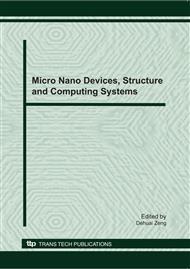[1]
T. Nagai, Y. Nademoto and T. Yano: Improvement of Physical Properties by Increase of Specific Surface Area of Starch Gel Powder. Nippon Shokuhin Kogyo Gakkaishi (Japanese). 38(6), 533–539. (1991).
DOI: 10.3136/nskkk1962.38.533
Google Scholar
[2]
J. Zhao and R.L. Whistler: Spherical Aggregates of Starch Granules as Flavor Carriers. Food Technol. 48, 104–105. (1994).
Google Scholar
[3]
Yao WeiRong and Yao HuiYuan: Adsorbent Characteristics of Porous Starch. Starch/Stärke. 54, 260–263. (2002).
DOI: 10.1002/1521-379x(200206)54:6<260::aid-star260>3.0.co;2-z
Google Scholar
[4]
Kazunori Nagata, Hirokazu Okamoto and Kazumi Danjo. Naproxen Particle Design Using Porous Starch. Drug Development and Industrial Pharmacy. 27 (4), 287–296. (2001).
DOI: 10.1081/ddc-100103728
Google Scholar
[5]
T. Yamada, M. Hisamatsu and K. Teranishi: Components of the Porous Maize Starch Granule Prepared by Amylase Treatment. Starch/Stärke. 47(9), 358-361. (1995).
DOI: 10.1002/star.19950470907
Google Scholar
[6]
S.J. McGrance, H.J. Cornell and C.J. Rix: A simple and rapid colorimetric method for the determination of amylose in starch products. Starch/Stärke. 50, 158–163. (1998).
DOI: 10.1002/(sici)1521-379x(199804)50:4<158::aid-star158>3.0.co;2-7
Google Scholar
[7]
J.C. Miller and J.N. Miller: Statistics for analytical chemistry. Ellis Horwood Ltd, Chichester. (1993. ).
Google Scholar
[8]
C.G. Oates: Towards an understanding of starch granule structure and hydrolysis. Trends Food Sci. Technol. 8, 375–382. (1997).
DOI: 10.1016/s0924-2244(97)01090-x
Google Scholar
[9]
J.Y. Li and A.I. Yeh: Relationships between thermal, rheological characteristics and swelling power for various starches. J Food Eng. 50: 141-148. (2001).
DOI: 10.1016/s0260-8774(00)00236-3
Google Scholar
[10]
C.K. Riley, A.O. Wheatley, I. Hassan, M.H. Ahmad, E.Y.S.A. Morrison and H.N. Asemota: In vitro digestibility of raw starches extracted from five yam (Dioscorea spp. ) species grown in Jamaica. Starch/Stärke. 56, 69–73. (2004).
DOI: 10.1002/star.200300195
Google Scholar
[11]
A.A. Karim, E.H. Sufha and I.S. M. Zaidul: Dual modification of starch via partial enzymatic hydrolysis in the granular state and subsequent hydroxypropylation.J. Agric Food Chem. 56, 10901-10907. (2008).
DOI: 10.1021/jf8015442
Google Scholar
[12]
N.W.H. Cheetham and L. Tao: Variation in crystalline type with amylose content in maize starch granules: An X-ray powder diffraction study. Carbohydr. Polym. 36, 277–284. (1998).
DOI: 10.1016/s0144-8617(98)00007-1
Google Scholar
[13]
D. Cooke and M.J. Gidley: Loss of crystalline and molecular order during starch gelatinization: origin of the enthalpic transition. Carbohydr. Res. 227, 103–112. (1992).
DOI: 10.1016/0008-6215(92)85063-6
Google Scholar
[14]
P.L. Russell: The ageing of gels from starches of different amylose/amylopectin cntent studied by differential scanning calorimetry. Journal of Cereal Science. 6, 147–158. (1987).
DOI: 10.1016/s0733-5210(87)80051-6
Google Scholar
[15]
R. Hoover: Composition, molecular structure, and physicochemical properties of tuber and root starches: a review. Carbohydrate Polymers. 45, 253–267. (2001).
DOI: 10.1016/s0144-8617(00)00260-5
Google Scholar


